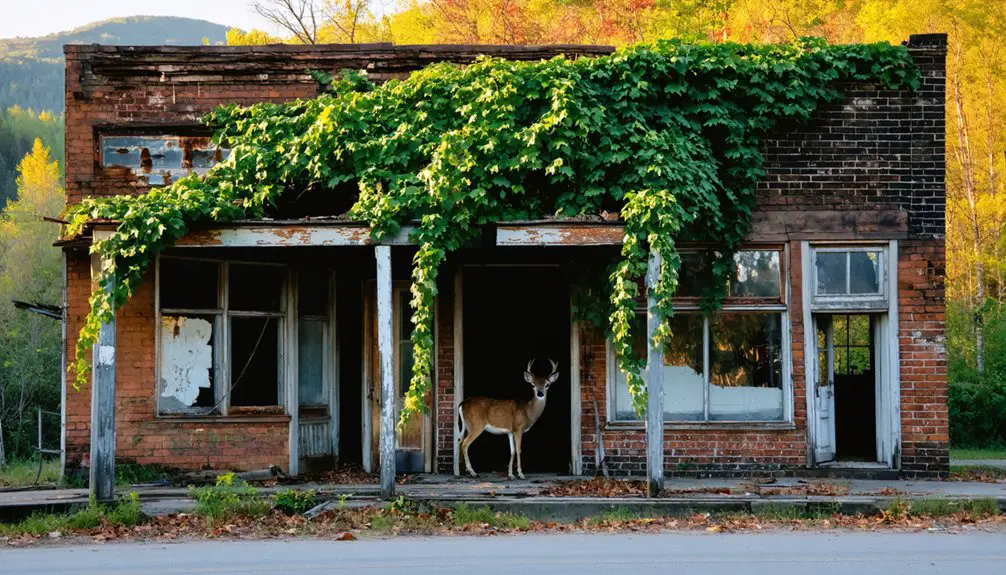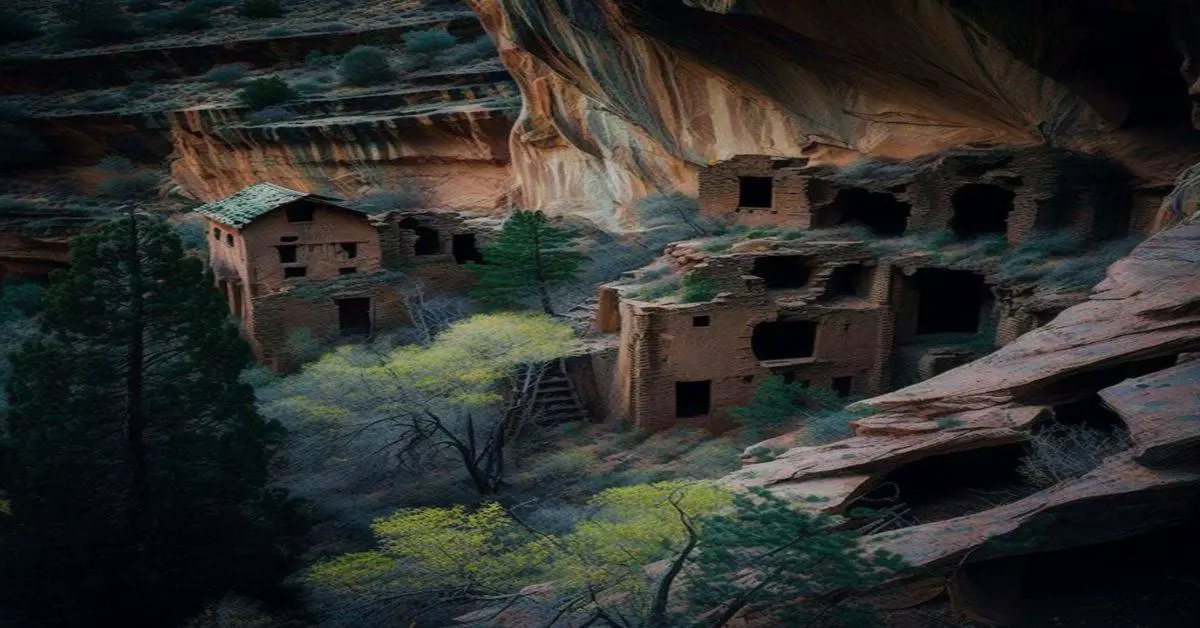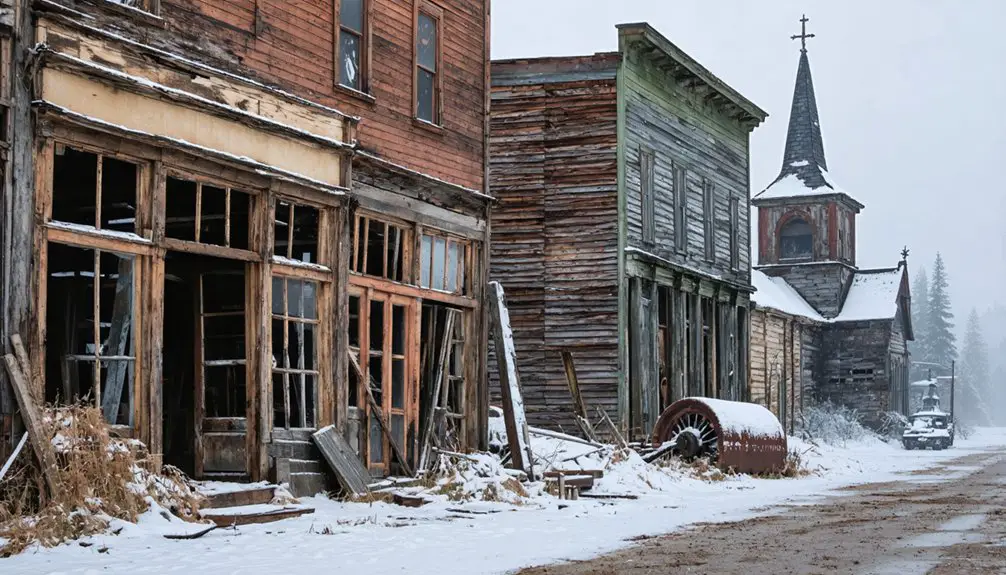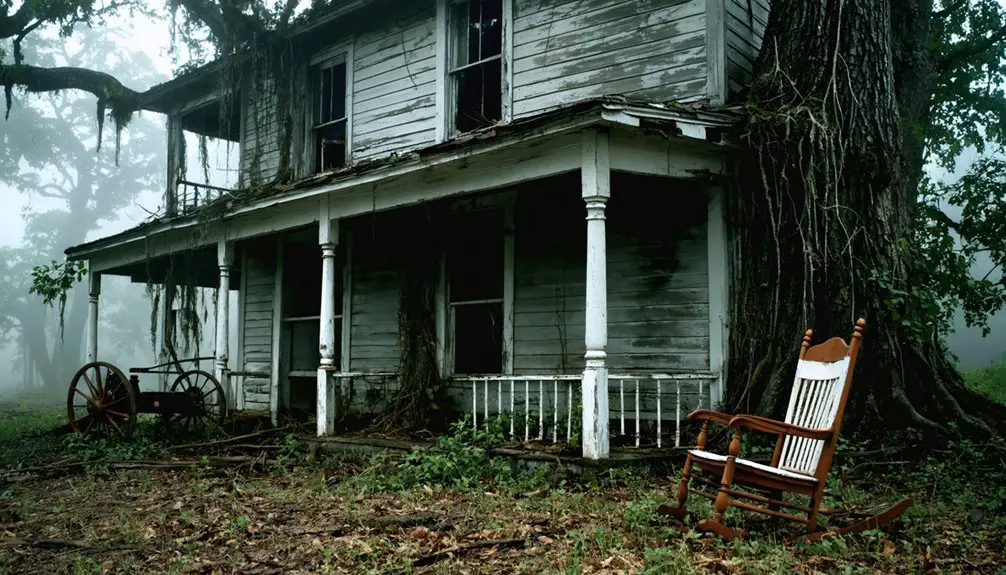You’ll find Rutherford nestled in West Virginia’s Appalachian Mountains, where abandoned mines and weathered buildings tell the story of a once-bustling coal town. After railroads arrived in 1883, it transformed into a crucial coal transport hub with diverse mining communities, company stores, and a thriving underground economy. Today, you can explore the ruins of Commercial Row, historic cemeteries, and sealed mine portals, while ghost stories and local legends add mystique to this mountain settlement’s rich past.
Key Takeaways
- Rutherford transformed from a bustling coal transport hub in the 1800s to a ghost town following the decline of the railroad industry.
- Commercial Row, once the town’s economic center, now consists mainly of weathered facades and ruins from the early 20th century.
- The abandoned brick passenger depot from 1900 stands as a reminder of Rutherford’s former importance in West Virginia’s coal transportation network.
- Local legends, including the “Lady in the Red Dress” ghost and “Black Mass Apparition,” contribute to the town’s haunted reputation.
- The National Park Service initiated preservation efforts in 2003 to maintain historic buildings, though much of the area remains inaccessible.
The Birth of a Mountain Settlement
As pioneers pushed westward into the Appalachian Mountains during the 18th and early 19th centuries, Rutherford emerged as a small but resilient settlement in West Virginia’s rugged terrain.
You’ll find that these early settlers, driven by the promise of land and resources, chose this location for its abundant water access and dense forests that provided essential timber for building and fuel.
Like many frontier settlements of the era that faced colonial encroachment, indigenous peoples were gradually displaced from their traditional lands.
The pioneer struggles were intense as families adapted to the mountainous environment, facing harsh winters and complex terrain. Like the settlers of Rutherford County who traveled the Great Wagon Road southward, these pioneers brought their determination and resourcefulness to tame the wilderness.
Pioneers endured brutal challenges while adapting to mountain life, battling fierce winters and navigating treacherous landscapes in their quest for survival.
Yet community resilience shone through as settlers worked together, establishing subsistence farms and supplementing their needs through hunting and gathering.
They formed a diverse group of European Americans, with possible indigenous allies, creating a cooperative society where shared labor became vital for survival in their isolated mountain haven.
Railroad’s Golden Era
In the late 1800s, you’d find Rutherford bustling as a critical coal transport hub, where trains hauled massive quantities of Appalachian coal to Eastern markets.
You could watch passenger trains roll through several times daily, connecting mountain residents to Charleston, Huntington, and beyond.
The railroad’s infrastructure included gravel ballast tracks that supported the heavy coal loads while keeping maintenance costs reasonable.
Much like the Confederate forces in Ramseur’s division, the rail station eventually found itself in retreat as industry evolved.
Coal Transport Hub
While major railroads crisscrossed southern West Virginia’s coalfields, Rutherford emerged as a strategic transport hub during the railroad’s golden era.
You’d find sophisticated transport logistics coordinating massive coal shipments through the region’s three main rail arteries – the C&O, N&W, and Virginian Railways. The West Virginia Northern Railroad operated consolidation steam locomotives to transport heavy coal loads from local mines.
The freight dynamics involved managing heavy locomotives and long coal trains that powered America’s industrial growth. The region faced significant disruption during the Great Railroad Strike of 1877 when workers protested wage cuts.
Peak Passenger Train Service
During the railroad’s golden era, Rutherford’s brick passenger depot stood as an essential transportation gateway that transformed local travel after its construction in 1900.
Initially accessed by wooden overpass, the depot’s road access in 1925 marked significant train innovations that improved passenger experiences.
You’d find daily trains connecting you to Cumberland, Maryland, and beyond, while the depot’s waiting rooms and ticket offices handled high volumes of travelers.
The service wasn’t just about moving people – you could receive everything from fashion goods to entire houses by rail.
Whether you were a coal worker, immigrant, or local resident seeking education or healthcare, the trains offered unprecedented freedom of movement.
This crucial link reduced isolation, enabling business opportunities and cultural exchanges throughout West Virginia and neighboring states. The depot served as a vital hub for the Davis Coal Company, facilitating the distribution of coal resources throughout the region.
The Henry Rogers investment of over $40 million in railway construction helped establish this critical transportation network.
Life in the Mining Boom
As railroads arrived in 1883, life in Rutherford transformed into a bustling coal mining community that attracted workers from diverse ethnic backgrounds.
Mining families faced harsh realities of long hours, dangerous conditions, and economic dependency through company-controlled housing and stores.
You’d find multiple generations working underground, with even young boys taking supporting roles in the mines. West Virginia enacted its first coal mining legislation in 1883 to establish safety inspections and oversight.
Life in Rutherford centered around:
- Company stores where you’d use scrip instead of cash
- Crowded mining camps filled with different ethnicities and cultures
- Daily struggles with poor ventilation and unsafe equipment
Labor struggles emerged as miners sought better wages and safer conditions, though mine operators strongly resisted these reforms.
The community’s social fabric grew stronger through shared hardships, creating lasting bonds across ethnic lines that would influence future labor movements.
Tales From the Underground Economy
If you’d traveled through Rutherford during its heyday, you’d have found bootleggers operating secret stills along the riverbanks, moving moonshine through an intricate network of backwater channels and hidden coves.
Much like the contrast between Wheeling and Ohio, these illicit operations highlighted the stark differences between states along the river.
High-stakes poker games drew coal miners who’d bet their weekly wages in smoke-filled backrooms, while company scrip circulated freely among players despite company rules forbidding such gambling.
After sunset, the underground cash economy thrived as miners traded coal scrip for real dollars through a web of informal brokers operating out of shanties and abandoned mine shacks.
Bootlegging Along River Banks
When Prohibition descended upon West Virginia in 1920, the state’s winding rivers and secluded banks transformed into essential arteries of an underground moonshine economy. You’d find bootleggers employing sophisticated river smuggling tactics, using the waterways as natural highways to move their illicit cargo while evading federal agents.
The resourceful moonshiners developed an intricate system:
- Small boats and hidden docks facilitated quick loading and unloading
- Bulk tanks were strategically transported via train stops near river towns
- Sharpshooting positions and guerrilla tactics protected smuggling routes
These river networks weren’t just transportation channels – they became lifelines for communities like Rutherford. Extended family ties and local sympathies created a protective shield around the operations, with bootleggers often dismantling and relocating their stills at a moment’s notice to avoid raids.
High-Stakes Poker Games
The illicit river trade wasn’t the only underground economy keeping Rutherford’s pulse beating – high-stakes poker games drew the region’s most daring players and wealthiest coal barons to its smoky backrooms.
You’d find these underground poker sessions running day and night, often lasting weeks or even months, much like the legendary 14-year game at nearby Dun Glen Hotel in Thurmond.
The stakes were astronomical – million-dollar mine deals were sealed over poker hands, while banking families and coal magnates battled for dominance across the felt.
Inside these dimly lit rooms, you’d witness more than just gambling; you’d see the raw machinery of power and commerce at work.
The poker tables became unofficial boardrooms where fortunes changed hands and the region’s economic future was quietly shaped.
Coal Money After Dark
Beneath moonlit streets and behind drawn curtains, Rutherford’s underground economy thrived as miners and their families carved out survival beyond the company store’s iron grip.
You’d find barter networks flourishing after dark, where economic resilience took many forms:
- Trading homemade goods and essential items through informal channels when company wages fell short
- Sharing food and resources through clandestine community gatherings away from watchful eyes
- Exchanging services and labor outside official channels to circumvent company control
These after-hours transactions became crucial lifelines during industry downturns, creating autonomous spaces where miners could resist economic exploitation.
In Rutherford’s shadows, you’d witness an intricate web of survival strategies that sustained families through the boom-and-bust cycles of coal country.
Notable Characters and Legends
As railroad tracks carved through the mountains of West Virginia, Rutherford’s most influential figure emerged in William Dabney Thurmond, a Confederate captain who received 73 acres for his surveying work with the Chesapeake and Ohio railroad.
The town’s reputation for lawlessness earned it the nickname “Dodge City of the East,” with tales of murders, robberies, and mysterious deaths plaguing its history.
Criminal folklore tells of outlaws using the isolated location as a hideout, while ghostly sightings continue to this day.
Hidden within the mountain’s shadows, this ghostly waypoint once sheltered fugitives and now harbors restless spirits of the past.
You’ll hear stories of the Lady in the Red Dress, spotted by mediums behind Commercial Row, and accounts of a menacing Black Mass apparition that’s frightened even seasoned ghost hunters.
The town’s dark past lives on through both supernatural encounters and grim stories of bodies found along the railroad tracks.
Architecture and Infrastructure
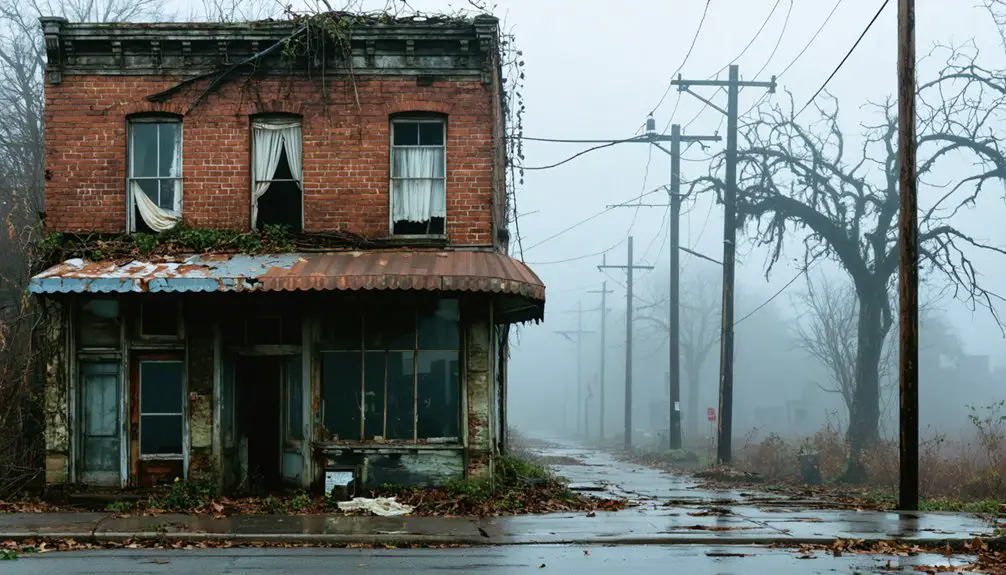
Standing prominently along the railroad tracks, Rutherford’s Commercial Row once bustled with activity during the town’s heyday, though today you’ll find mostly ruins and weathered facades.
The abandoned houses behind the commercial district showcase typical early 20th century Appalachian architecture with gabled roofs and wood siding, though most are now dangerously unstable.
Historical preservation efforts by the National Park Service began in 2003, focusing on:
- Stabilizing original railroad-era structures
- Maintaining historic building elements while preventing collapse
- Repurposing select buildings while preserving their foundations
Infrastructure remains minimal, with access via a narrow paved road from Glen Jean.
The original streets are still visible but often closed off, and most buildings lack modern utilities beyond basic stabilization work.
The Path to Abandonment
Though Rutherford thrived during the golden age of steam locomotives and coal mining, its fate was sealed by an intricate web of economic and social factors.
You’ll find that multiple forces converged to accelerate the town’s downfall: the national decline of coal demand, the shift away from steam engines, and the loss of railroad traffic all dealt devastating economic blows.
The town’s social fabric unraveled as jobs disappeared and infrastructure crumbled.
Despite the founder’s attempts to maintain order through strict Baptist laws, Rutherford gained notoriety for lawlessness and violence.
Labor disputes, gambling, and criminal activity created an atmosphere of instability that drove away potential residents and investors.
Present-Day Remnants
When you visit Rutherford today, you’ll find a haunting mix of natural reclamation and structural decay spread across the former coal town’s footprint.
Time and nature slowly erase Rutherford’s industrial past, leaving only crumbling structures to tell tales of coal-mining glory days.
Nature’s reclamation is evident as trees, vines, and shrubs steadily consume the ghostly echoes of this once-bustling community.
Among the most notable remnants you’ll discover:
- The partially visible Main Depot building stands alongside ruined railway structures, with abandoned tracks now serving as hiking trails
- Historic buildings including an old church and seasonal homes fitted with Christmas lights, showing sparse but persistent human presence
- Cemeteries containing late 19th-century gravestones that memorialize Royal Coal Mine workers, though some have been relocated due to New River flooding
Rusted coal tipples, sealed mine portals, and scattered industrial artifacts complete this atmospheric representation of Appalachian coal heritage.
Preserving Mountain Heritage
As part of West Virginia’s extensive heritage preservation framework, Rutherford’s mountain legacy benefits from both state and federal protection initiatives.
You’ll find this ghost town’s preservation efforts aligned with the State Historic Preservation Office‘s mission, which has documented over 3,000 historic structures across West Virginia since 1977.
The Appalachian Forest National Heritage Area‘s designation in 2019 strengthens heritage conservation through community engagement and sustainable tourism.
You can participate in ranger-led programs and volunteer initiatives that connect you directly to mountain heritage preservation.
Local partnerships and youth education programs guarantee Rutherford’s story lives on, while the broader National Heritage Area network provides essential funding support.
These combined efforts help protect not just Rutherford’s remnants, but the entire cultural landscape of West Virginia’s mountain communities.
Frequently Asked Questions
How Dangerous Is It to Explore the Abandoned Buildings Today?
Walking into abandoned buildings is like dancing with death. You’re facing serious risks during urban exploration – structural collapse, toxic materials, and wildlife hazards require strict safety precautions to avoid disaster.
Are There Any Documented Paranormal Activities or Ghost Sightings?
You won’t find solid evidence of ghostly encounters or spectral sightings here – while local legends hint at paranormal activity from the town’s violent past, there aren’t any well-documented cases to verify these claims.
What Was the Highest Recorded Population During Rutherford’s Peak Years?
While you might think a bustling railroad town would’ve had thousands, Rutherford’s history shows its peak population reached 462 residents in 1930, before rapid population decline transformed it into today’s ghost town.
Can Visitors Legally Collect Artifacts or Souvenirs From the Site?
You can’t legally collect artifacts or souvenirs from historical sites due to strict legal regulations and artifact preservation laws. Any removal without proper permits could result in fines or prosecution.
What Natural Disasters Have Impacted the Town’s Remaining Structures?
With 80% of damage from wind exposure, you’ll see natural erosion’s dramatic impact through seasonal flooding, harsh mountain storms, and structural decay accelerated by decades without maintenance or repair.
References
- https://www.legendsofamerica.com/thurmond-west-virginia/
- https://www.youtube.com/watch?v=yBKOIRxeNX0
- https://minskysabandoned.com/2015/08/06/west-virginia-ghost-towns-part-2-thurmond/
- https://www.caseybarber.com/thurmond-wv/
- https://www.youtube.com/watch?v=2x_SbnBKfq4
- https://theblueridgehighlander.com/rutherford-county-north-carolina-history.php
- https://www.ncpedia.org/anchor/rutherford-expedition
- https://smokymountainnews.com/archives/item/13169-rutherford-trace-local-historians-examine-the-legacy-of-a-shock-and-awe-revolutionary-war-campaign-against-the-cherokee
- https://amrevnc.com/rutherford-trace/
- https://www.rbhayes.org/research/chapter-8-camp-life-in-west-virginia/
